Process Orientation Requirements: VLE System Development
VerifiedAdded on 2022/10/17
|12
|2044
|203
Project
AI Summary
This project delves into the process orientation requirements for a Virtual Learning Environment (VLE) system, encompassing requirements identification, modeling, and system design. The project begins with the creation of SysML diagrams, including requirements and use case diagrams (both business and product use cases), to define the system's functionalities and user interactions. The second part of the project proposes a technical solution for the VLE system, detailing the development platform (C# with Visual Studio), system architecture (block diagram), and system behavior (sequence diagram). The solution emphasizes automation of manual procedures, personalization of education, and the development of an information system for users, supported by data storage and monitoring capabilities. The project concludes with a report on the proposed viewpoint application, highlighting the benefits of workflow automation, personalized learning approaches, and efficient data management within the VLE system, with a strong emphasis on the system's ability to cater to students and educators. The project also touches upon the GDPR law enforcement and ethical considerations that influence the system's design and processes.
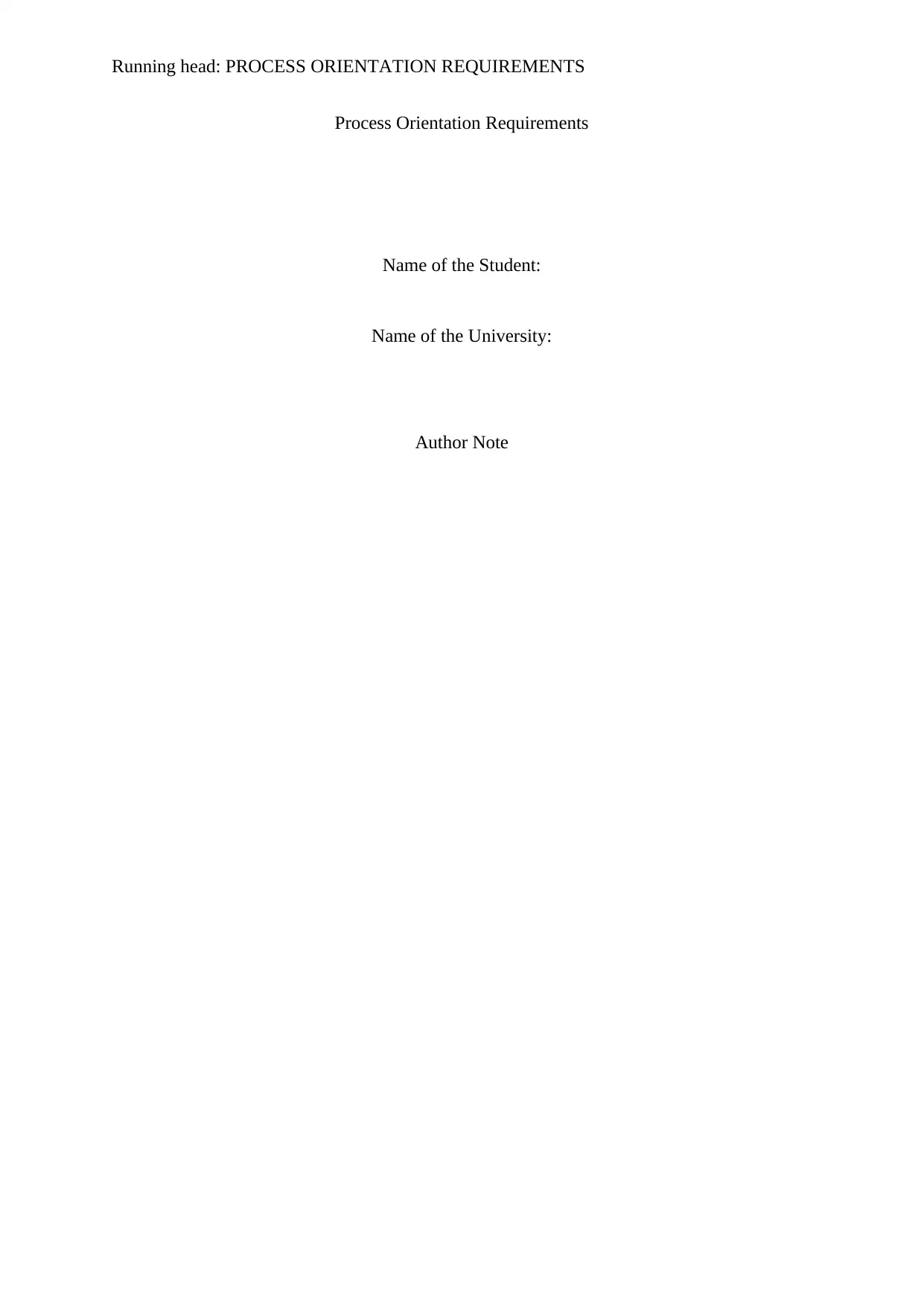
Running head: PROCESS ORIENTATION REQUIREMENTS
Process Orientation Requirements
Name of the Student:
Name of the University:
Author Note
Process Orientation Requirements
Name of the Student:
Name of the University:
Author Note
Paraphrase This Document
Need a fresh take? Get an instant paraphrase of this document with our AI Paraphraser
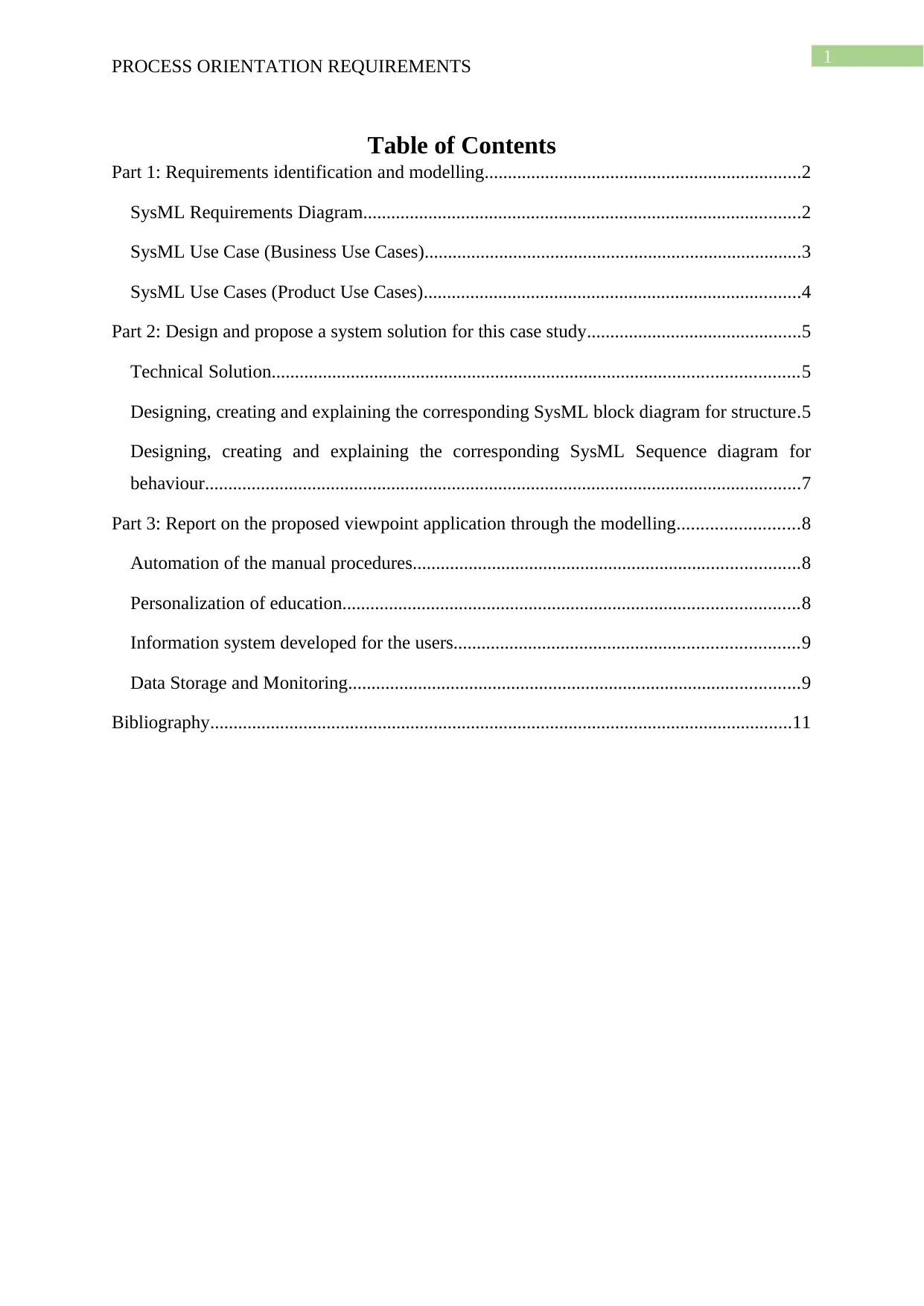
1
PROCESS ORIENTATION REQUIREMENTS
Table of Contents
Part 1: Requirements identification and modelling....................................................................2
SysML Requirements Diagram..............................................................................................2
SysML Use Case (Business Use Cases).................................................................................3
SysML Use Cases (Product Use Cases).................................................................................4
Part 2: Design and propose a system solution for this case study..............................................5
Technical Solution.................................................................................................................5
Designing, creating and explaining the corresponding SysML block diagram for structure.5
Designing, creating and explaining the corresponding SysML Sequence diagram for
behaviour................................................................................................................................7
Part 3: Report on the proposed viewpoint application through the modelling..........................8
Automation of the manual procedures...................................................................................8
Personalization of education..................................................................................................8
Information system developed for the users..........................................................................9
Data Storage and Monitoring.................................................................................................9
Bibliography.............................................................................................................................11
PROCESS ORIENTATION REQUIREMENTS
Table of Contents
Part 1: Requirements identification and modelling....................................................................2
SysML Requirements Diagram..............................................................................................2
SysML Use Case (Business Use Cases).................................................................................3
SysML Use Cases (Product Use Cases).................................................................................4
Part 2: Design and propose a system solution for this case study..............................................5
Technical Solution.................................................................................................................5
Designing, creating and explaining the corresponding SysML block diagram for structure.5
Designing, creating and explaining the corresponding SysML Sequence diagram for
behaviour................................................................................................................................7
Part 3: Report on the proposed viewpoint application through the modelling..........................8
Automation of the manual procedures...................................................................................8
Personalization of education..................................................................................................8
Information system developed for the users..........................................................................9
Data Storage and Monitoring.................................................................................................9
Bibliography.............................................................................................................................11
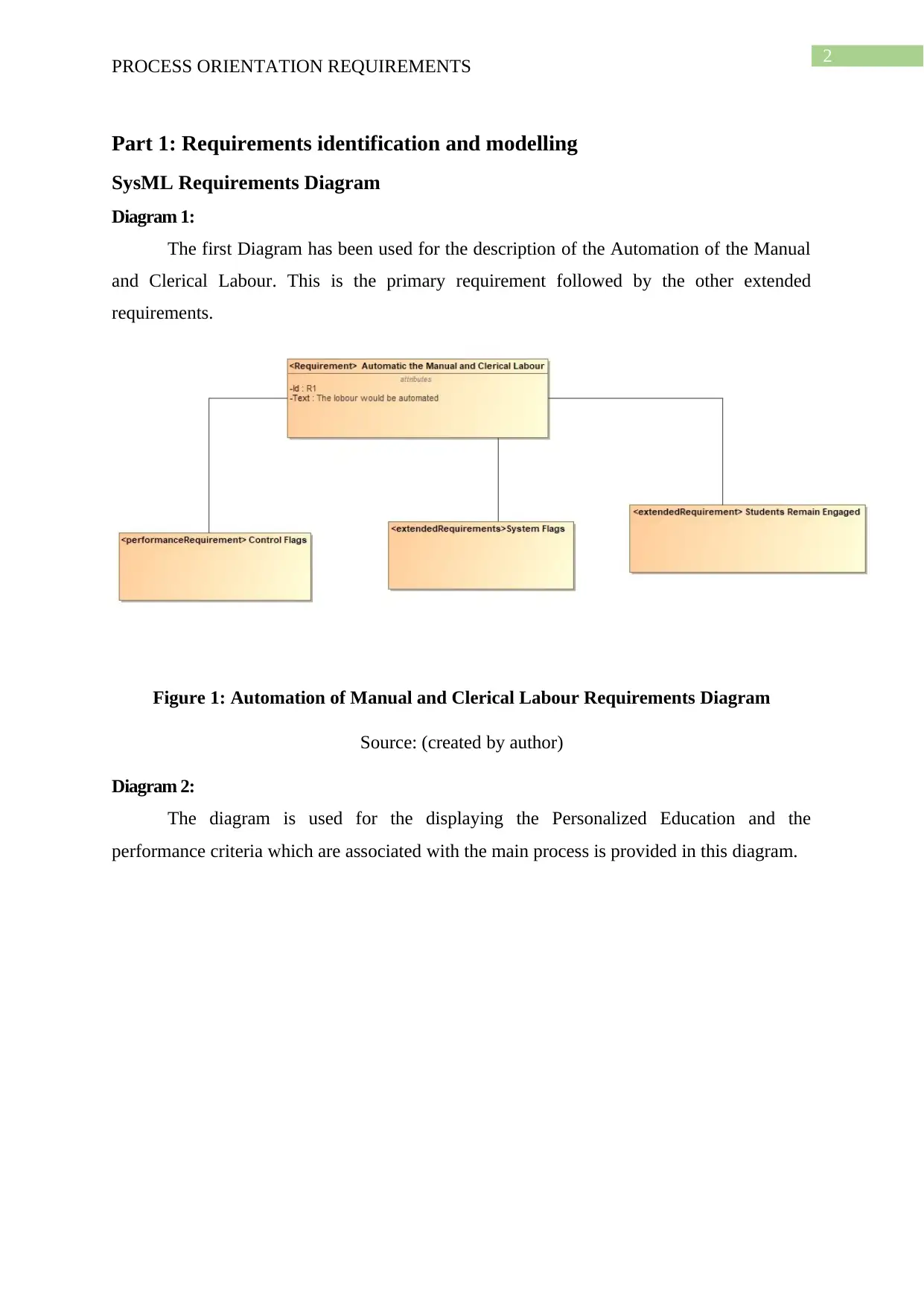
2
PROCESS ORIENTATION REQUIREMENTS
Part 1: Requirements identification and modelling
SysML Requirements Diagram
Diagram 1:
The first Diagram has been used for the description of the Automation of the Manual
and Clerical Labour. This is the primary requirement followed by the other extended
requirements.
Figure 1: Automation of Manual and Clerical Labour Requirements Diagram
Source: (created by author)
Diagram 2:
The diagram is used for the displaying the Personalized Education and the
performance criteria which are associated with the main process is provided in this diagram.
PROCESS ORIENTATION REQUIREMENTS
Part 1: Requirements identification and modelling
SysML Requirements Diagram
Diagram 1:
The first Diagram has been used for the description of the Automation of the Manual
and Clerical Labour. This is the primary requirement followed by the other extended
requirements.
Figure 1: Automation of Manual and Clerical Labour Requirements Diagram
Source: (created by author)
Diagram 2:
The diagram is used for the displaying the Personalized Education and the
performance criteria which are associated with the main process is provided in this diagram.
You're viewing a preview
Unlock full access by subscribing today!
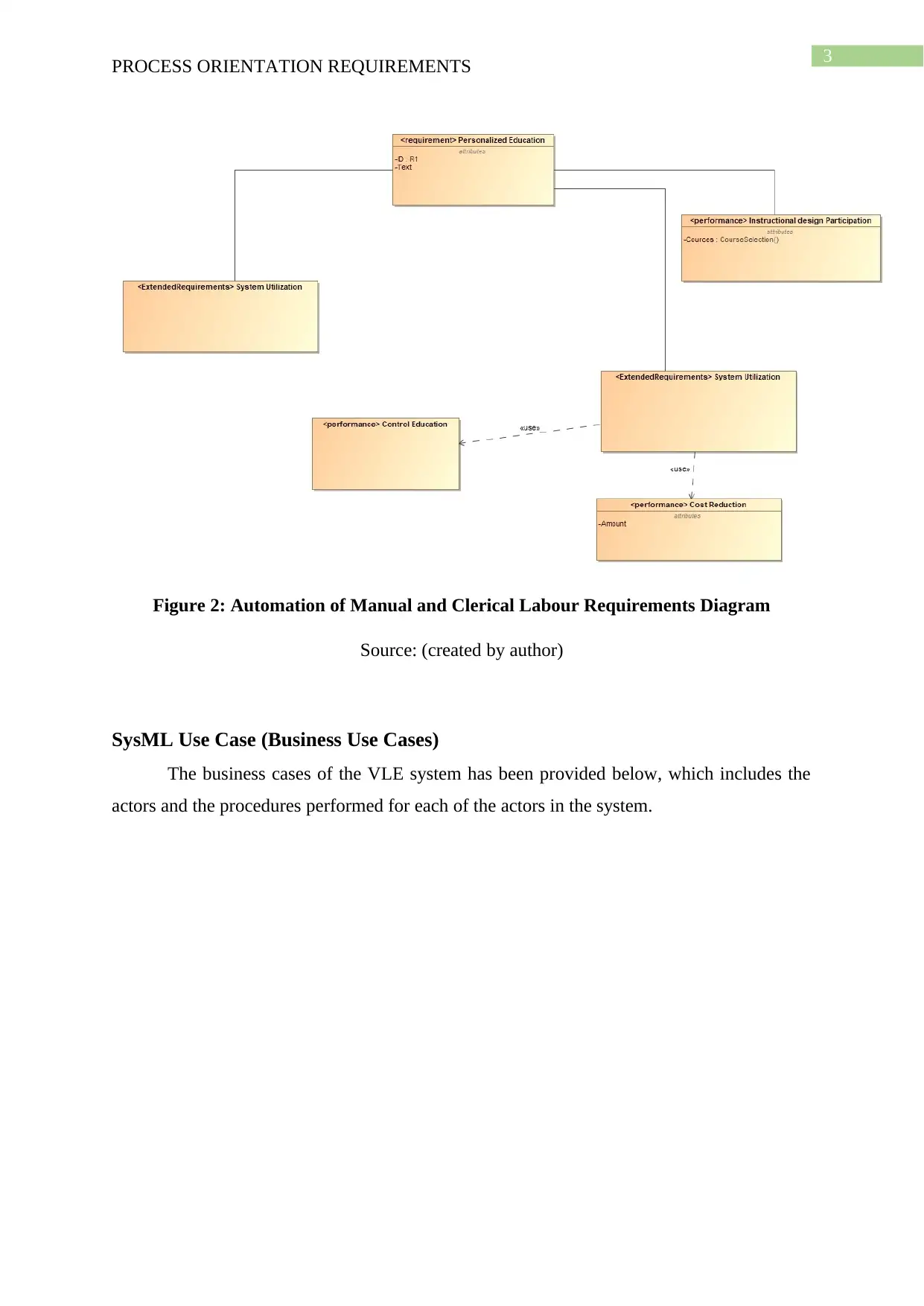
3
PROCESS ORIENTATION REQUIREMENTS
Figure 2: Automation of Manual and Clerical Labour Requirements Diagram
Source: (created by author)
SysML Use Case (Business Use Cases)
The business cases of the VLE system has been provided below, which includes the
actors and the procedures performed for each of the actors in the system.
PROCESS ORIENTATION REQUIREMENTS
Figure 2: Automation of Manual and Clerical Labour Requirements Diagram
Source: (created by author)
SysML Use Case (Business Use Cases)
The business cases of the VLE system has been provided below, which includes the
actors and the procedures performed for each of the actors in the system.
Paraphrase This Document
Need a fresh take? Get an instant paraphrase of this document with our AI Paraphraser
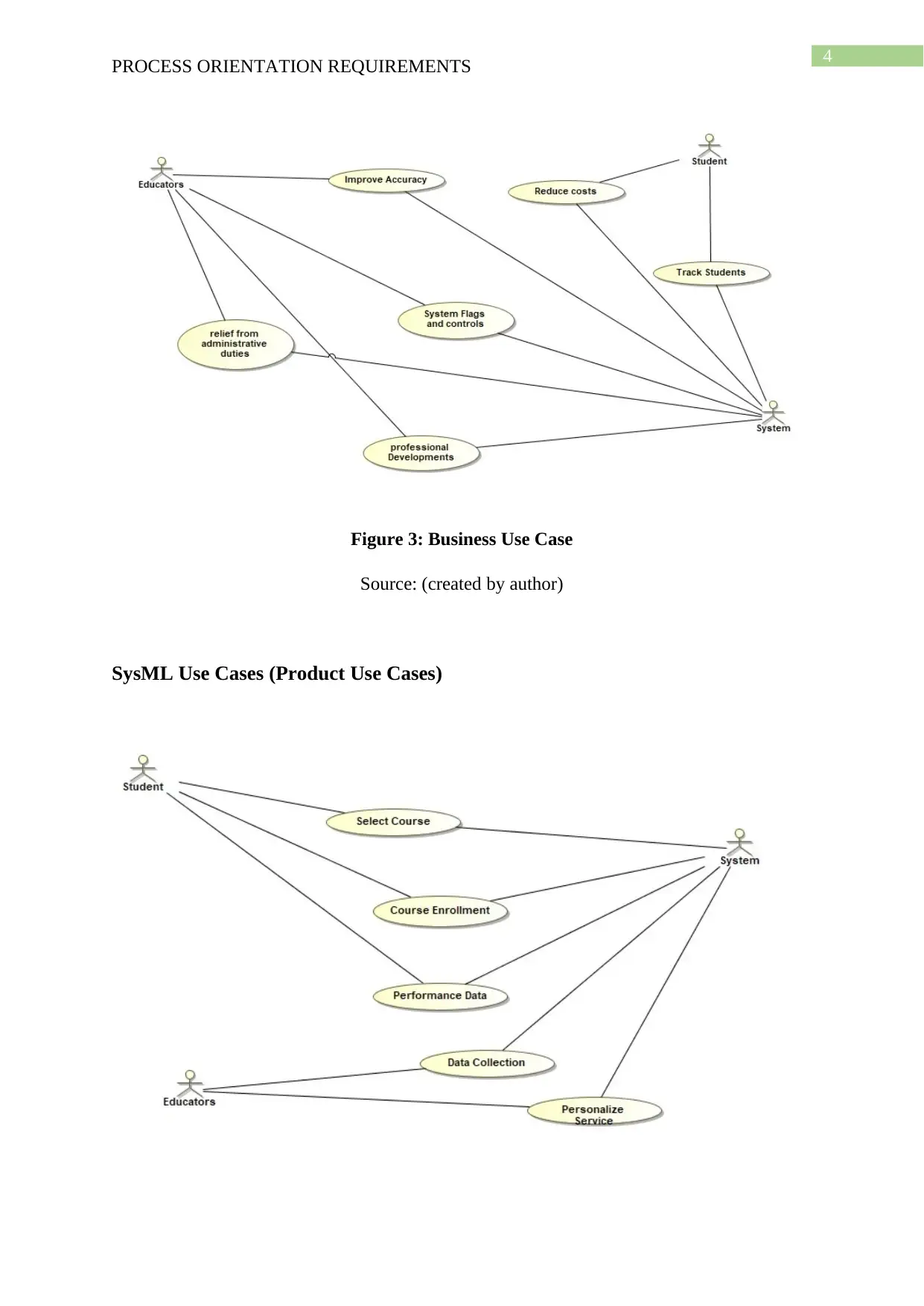
4
PROCESS ORIENTATION REQUIREMENTS
Figure 3: Business Use Case
Source: (created by author)
SysML Use Cases (Product Use Cases)
PROCESS ORIENTATION REQUIREMENTS
Figure 3: Business Use Case
Source: (created by author)
SysML Use Cases (Product Use Cases)
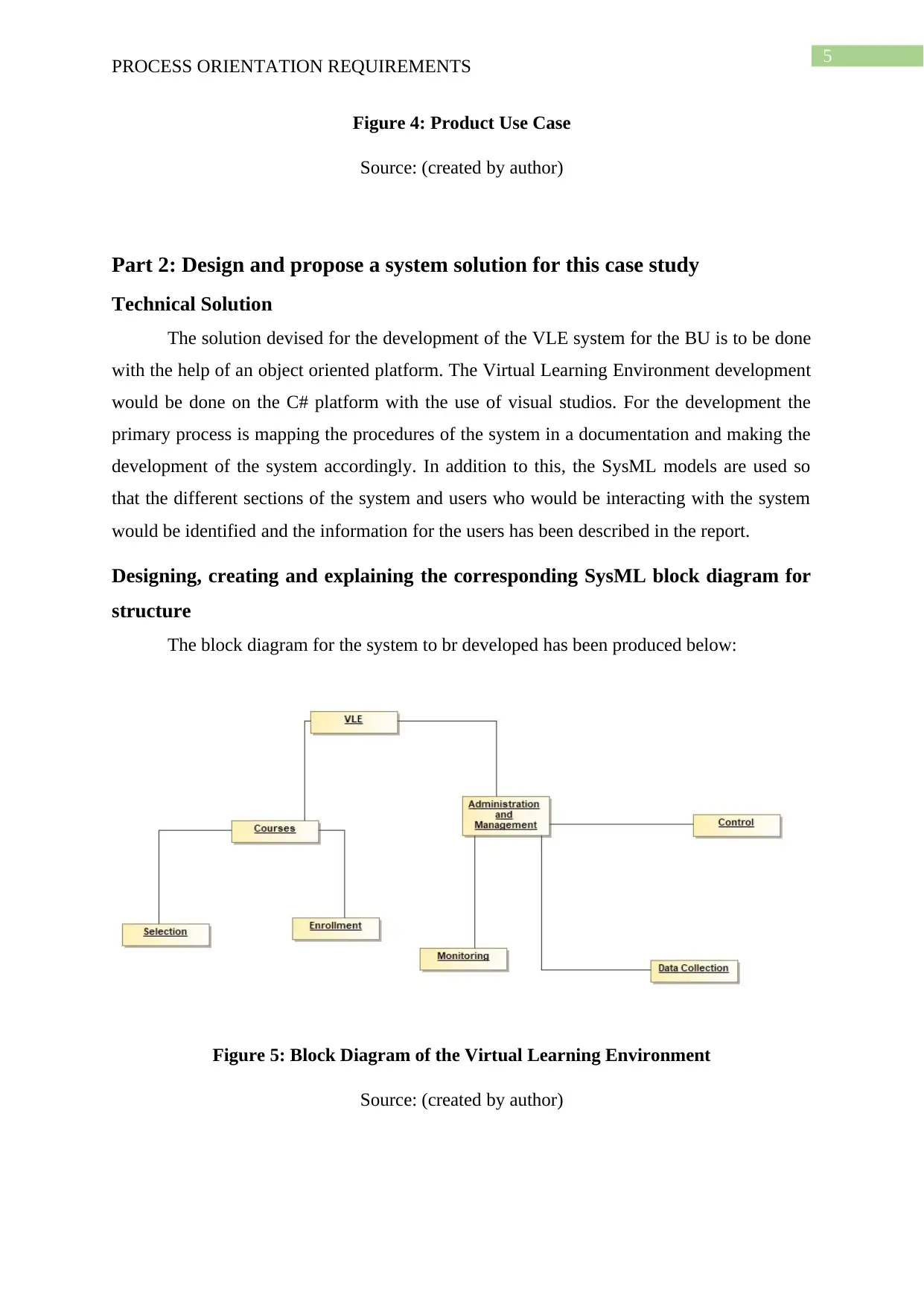
5
PROCESS ORIENTATION REQUIREMENTS
Figure 4: Product Use Case
Source: (created by author)
Part 2: Design and propose a system solution for this case study
Technical Solution
The solution devised for the development of the VLE system for the BU is to be done
with the help of an object oriented platform. The Virtual Learning Environment development
would be done on the C# platform with the use of visual studios. For the development the
primary process is mapping the procedures of the system in a documentation and making the
development of the system accordingly. In addition to this, the SysML models are used so
that the different sections of the system and users who would be interacting with the system
would be identified and the information for the users has been described in the report.
Designing, creating and explaining the corresponding SysML block diagram for
structure
The block diagram for the system to br developed has been produced below:
Figure 5: Block Diagram of the Virtual Learning Environment
Source: (created by author)
PROCESS ORIENTATION REQUIREMENTS
Figure 4: Product Use Case
Source: (created by author)
Part 2: Design and propose a system solution for this case study
Technical Solution
The solution devised for the development of the VLE system for the BU is to be done
with the help of an object oriented platform. The Virtual Learning Environment development
would be done on the C# platform with the use of visual studios. For the development the
primary process is mapping the procedures of the system in a documentation and making the
development of the system accordingly. In addition to this, the SysML models are used so
that the different sections of the system and users who would be interacting with the system
would be identified and the information for the users has been described in the report.
Designing, creating and explaining the corresponding SysML block diagram for
structure
The block diagram for the system to br developed has been produced below:
Figure 5: Block Diagram of the Virtual Learning Environment
Source: (created by author)
You're viewing a preview
Unlock full access by subscribing today!
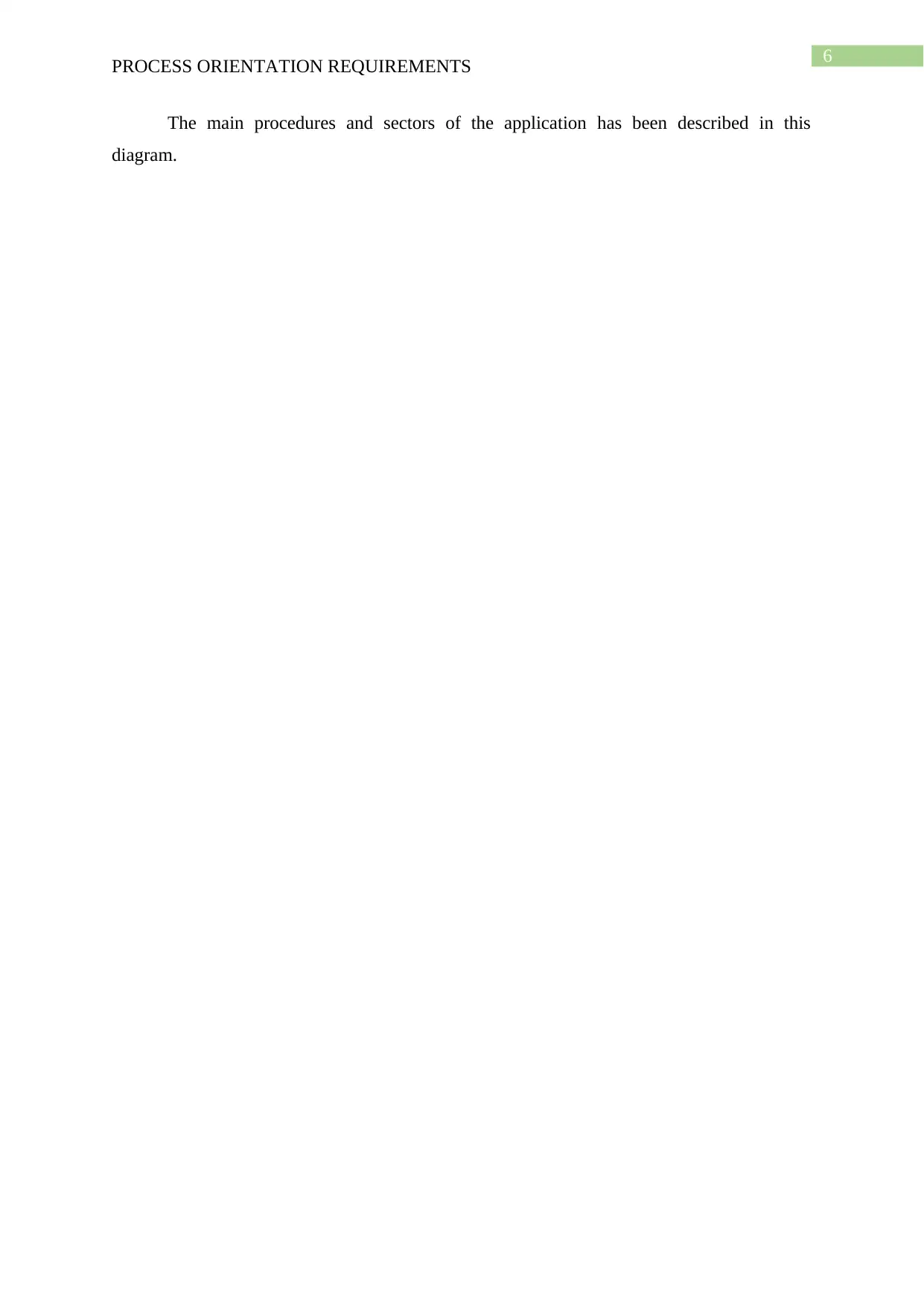
6
PROCESS ORIENTATION REQUIREMENTS
The main procedures and sectors of the application has been described in this
diagram.
PROCESS ORIENTATION REQUIREMENTS
The main procedures and sectors of the application has been described in this
diagram.
Paraphrase This Document
Need a fresh take? Get an instant paraphrase of this document with our AI Paraphraser
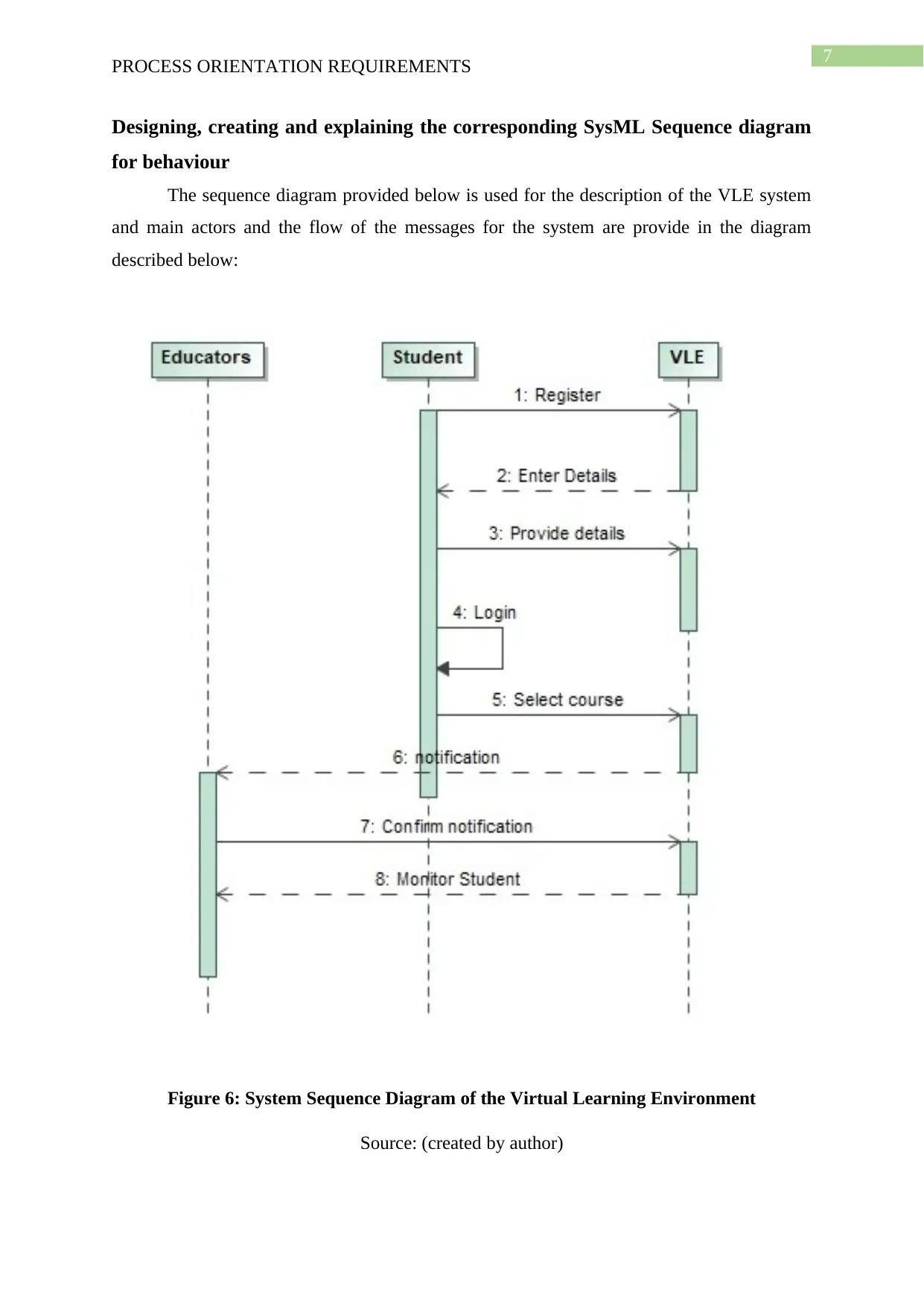
7
PROCESS ORIENTATION REQUIREMENTS
Designing, creating and explaining the corresponding SysML Sequence diagram
for behaviour
The sequence diagram provided below is used for the description of the VLE system
and main actors and the flow of the messages for the system are provide in the diagram
described below:
Figure 6: System Sequence Diagram of the Virtual Learning Environment
Source: (created by author)
PROCESS ORIENTATION REQUIREMENTS
Designing, creating and explaining the corresponding SysML Sequence diagram
for behaviour
The sequence diagram provided below is used for the description of the VLE system
and main actors and the flow of the messages for the system are provide in the diagram
described below:
Figure 6: System Sequence Diagram of the Virtual Learning Environment
Source: (created by author)
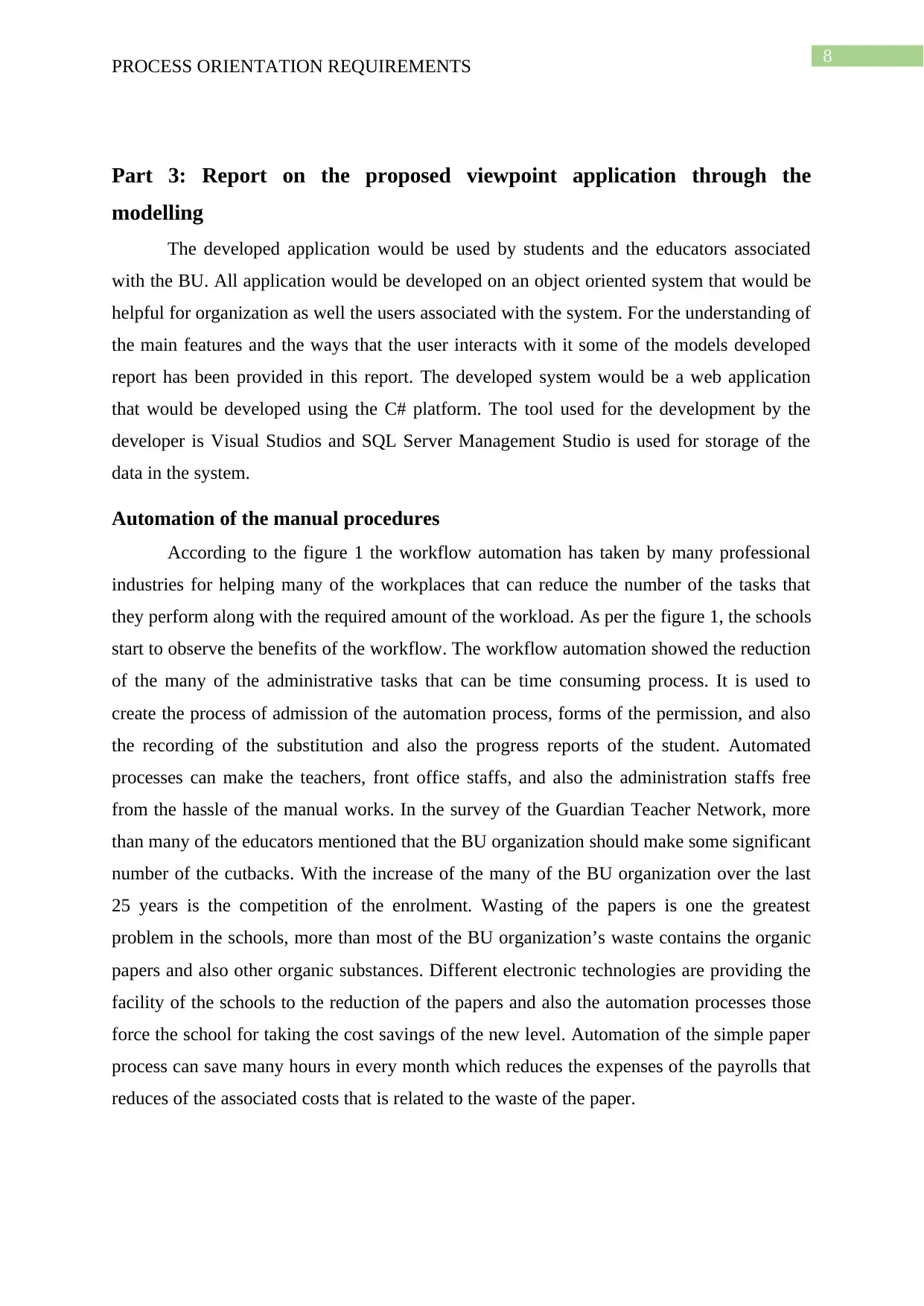
8
PROCESS ORIENTATION REQUIREMENTS
Part 3: Report on the proposed viewpoint application through the
modelling
The developed application would be used by students and the educators associated
with the BU. All application would be developed on an object oriented system that would be
helpful for organization as well the users associated with the system. For the understanding of
the main features and the ways that the user interacts with it some of the models developed
report has been provided in this report. The developed system would be a web application
that would be developed using the C# platform. The tool used for the development by the
developer is Visual Studios and SQL Server Management Studio is used for storage of the
data in the system.
Automation of the manual procedures
According to the figure 1 the workflow automation has taken by many professional
industries for helping many of the workplaces that can reduce the number of the tasks that
they perform along with the required amount of the workload. As per the figure 1, the schools
start to observe the benefits of the workflow. The workflow automation showed the reduction
of the many of the administrative tasks that can be time consuming process. It is used to
create the process of admission of the automation process, forms of the permission, and also
the recording of the substitution and also the progress reports of the student. Automated
processes can make the teachers, front office staffs, and also the administration staffs free
from the hassle of the manual works. In the survey of the Guardian Teacher Network, more
than many of the educators mentioned that the BU organization should make some significant
number of the cutbacks. With the increase of the many of the BU organization over the last
25 years is the competition of the enrolment. Wasting of the papers is one the greatest
problem in the schools, more than most of the BU organization’s waste contains the organic
papers and also other organic substances. Different electronic technologies are providing the
facility of the schools to the reduction of the papers and also the automation processes those
force the school for taking the cost savings of the new level. Automation of the simple paper
process can save many hours in every month which reduces the expenses of the payrolls that
reduces of the associated costs that is related to the waste of the paper.
PROCESS ORIENTATION REQUIREMENTS
Part 3: Report on the proposed viewpoint application through the
modelling
The developed application would be used by students and the educators associated
with the BU. All application would be developed on an object oriented system that would be
helpful for organization as well the users associated with the system. For the understanding of
the main features and the ways that the user interacts with it some of the models developed
report has been provided in this report. The developed system would be a web application
that would be developed using the C# platform. The tool used for the development by the
developer is Visual Studios and SQL Server Management Studio is used for storage of the
data in the system.
Automation of the manual procedures
According to the figure 1 the workflow automation has taken by many professional
industries for helping many of the workplaces that can reduce the number of the tasks that
they perform along with the required amount of the workload. As per the figure 1, the schools
start to observe the benefits of the workflow. The workflow automation showed the reduction
of the many of the administrative tasks that can be time consuming process. It is used to
create the process of admission of the automation process, forms of the permission, and also
the recording of the substitution and also the progress reports of the student. Automated
processes can make the teachers, front office staffs, and also the administration staffs free
from the hassle of the manual works. In the survey of the Guardian Teacher Network, more
than many of the educators mentioned that the BU organization should make some significant
number of the cutbacks. With the increase of the many of the BU organization over the last
25 years is the competition of the enrolment. Wasting of the papers is one the greatest
problem in the schools, more than most of the BU organization’s waste contains the organic
papers and also other organic substances. Different electronic technologies are providing the
facility of the schools to the reduction of the papers and also the automation processes those
force the school for taking the cost savings of the new level. Automation of the simple paper
process can save many hours in every month which reduces the expenses of the payrolls that
reduces of the associated costs that is related to the waste of the paper.
You're viewing a preview
Unlock full access by subscribing today!
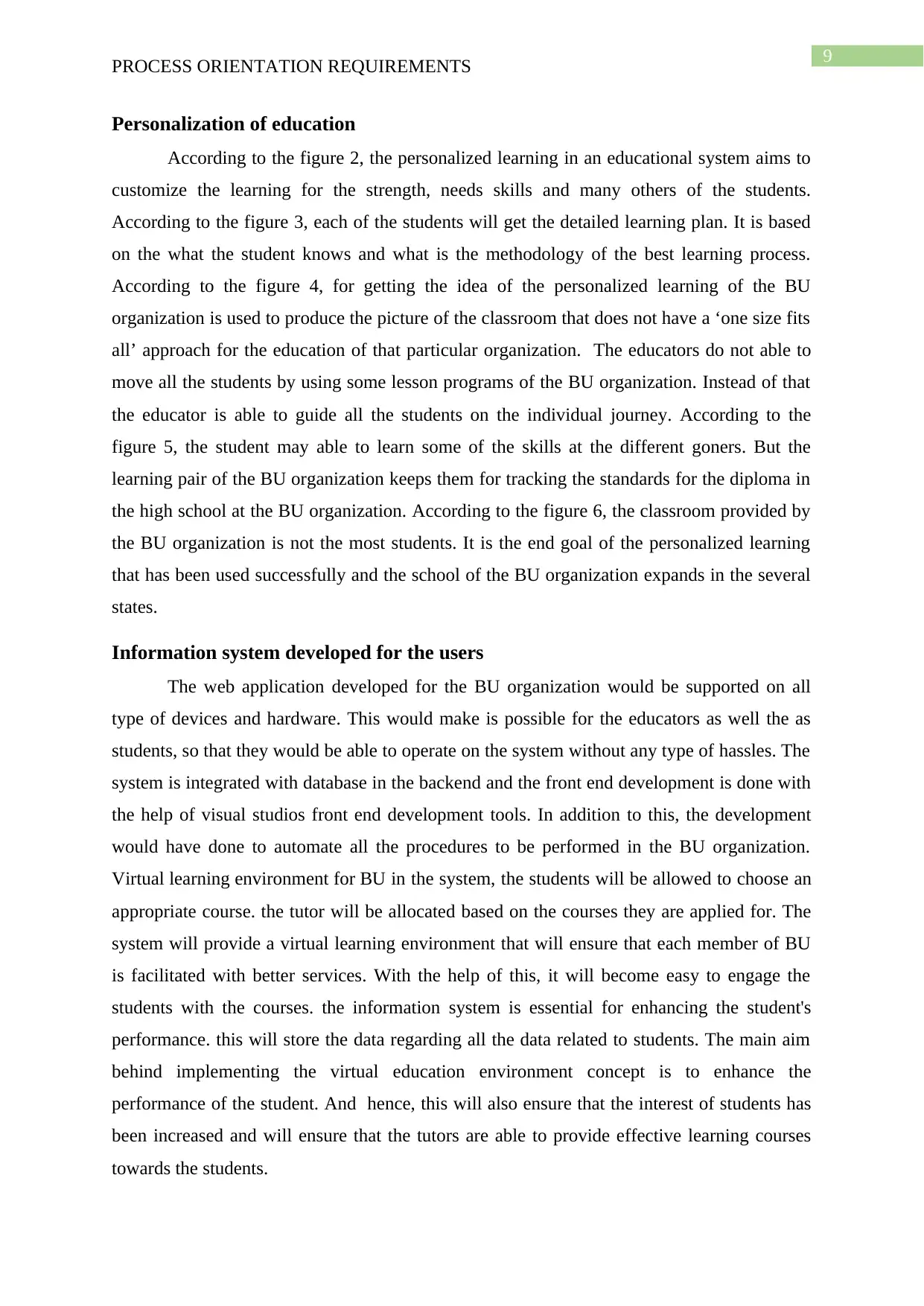
9
PROCESS ORIENTATION REQUIREMENTS
Personalization of education
According to the figure 2, the personalized learning in an educational system aims to
customize the learning for the strength, needs skills and many others of the students.
According to the figure 3, each of the students will get the detailed learning plan. It is based
on the what the student knows and what is the methodology of the best learning process.
According to the figure 4, for getting the idea of the personalized learning of the BU
organization is used to produce the picture of the classroom that does not have a ‘one size fits
all’ approach for the education of that particular organization. The educators do not able to
move all the students by using some lesson programs of the BU organization. Instead of that
the educator is able to guide all the students on the individual journey. According to the
figure 5, the student may able to learn some of the skills at the different goners. But the
learning pair of the BU organization keeps them for tracking the standards for the diploma in
the high school at the BU organization. According to the figure 6, the classroom provided by
the BU organization is not the most students. It is the end goal of the personalized learning
that has been used successfully and the school of the BU organization expands in the several
states.
Information system developed for the users
The web application developed for the BU organization would be supported on all
type of devices and hardware. This would make is possible for the educators as well the as
students, so that they would be able to operate on the system without any type of hassles. The
system is integrated with database in the backend and the front end development is done with
the help of visual studios front end development tools. In addition to this, the development
would have done to automate all the procedures to be performed in the BU organization.
Virtual learning environment for BU in the system, the students will be allowed to choose an
appropriate course. the tutor will be allocated based on the courses they are applied for. The
system will provide a virtual learning environment that will ensure that each member of BU
is facilitated with better services. With the help of this, it will become easy to engage the
students with the courses. the information system is essential for enhancing the student's
performance. this will store the data regarding all the data related to students. The main aim
behind implementing the virtual education environment concept is to enhance the
performance of the student. And hence, this will also ensure that the interest of students has
been increased and will ensure that the tutors are able to provide effective learning courses
towards the students.
PROCESS ORIENTATION REQUIREMENTS
Personalization of education
According to the figure 2, the personalized learning in an educational system aims to
customize the learning for the strength, needs skills and many others of the students.
According to the figure 3, each of the students will get the detailed learning plan. It is based
on the what the student knows and what is the methodology of the best learning process.
According to the figure 4, for getting the idea of the personalized learning of the BU
organization is used to produce the picture of the classroom that does not have a ‘one size fits
all’ approach for the education of that particular organization. The educators do not able to
move all the students by using some lesson programs of the BU organization. Instead of that
the educator is able to guide all the students on the individual journey. According to the
figure 5, the student may able to learn some of the skills at the different goners. But the
learning pair of the BU organization keeps them for tracking the standards for the diploma in
the high school at the BU organization. According to the figure 6, the classroom provided by
the BU organization is not the most students. It is the end goal of the personalized learning
that has been used successfully and the school of the BU organization expands in the several
states.
Information system developed for the users
The web application developed for the BU organization would be supported on all
type of devices and hardware. This would make is possible for the educators as well the as
students, so that they would be able to operate on the system without any type of hassles. The
system is integrated with database in the backend and the front end development is done with
the help of visual studios front end development tools. In addition to this, the development
would have done to automate all the procedures to be performed in the BU organization.
Virtual learning environment for BU in the system, the students will be allowed to choose an
appropriate course. the tutor will be allocated based on the courses they are applied for. The
system will provide a virtual learning environment that will ensure that each member of BU
is facilitated with better services. With the help of this, it will become easy to engage the
students with the courses. the information system is essential for enhancing the student's
performance. this will store the data regarding all the data related to students. The main aim
behind implementing the virtual education environment concept is to enhance the
performance of the student. And hence, this will also ensure that the interest of students has
been increased and will ensure that the tutors are able to provide effective learning courses
towards the students.
Paraphrase This Document
Need a fresh take? Get an instant paraphrase of this document with our AI Paraphraser
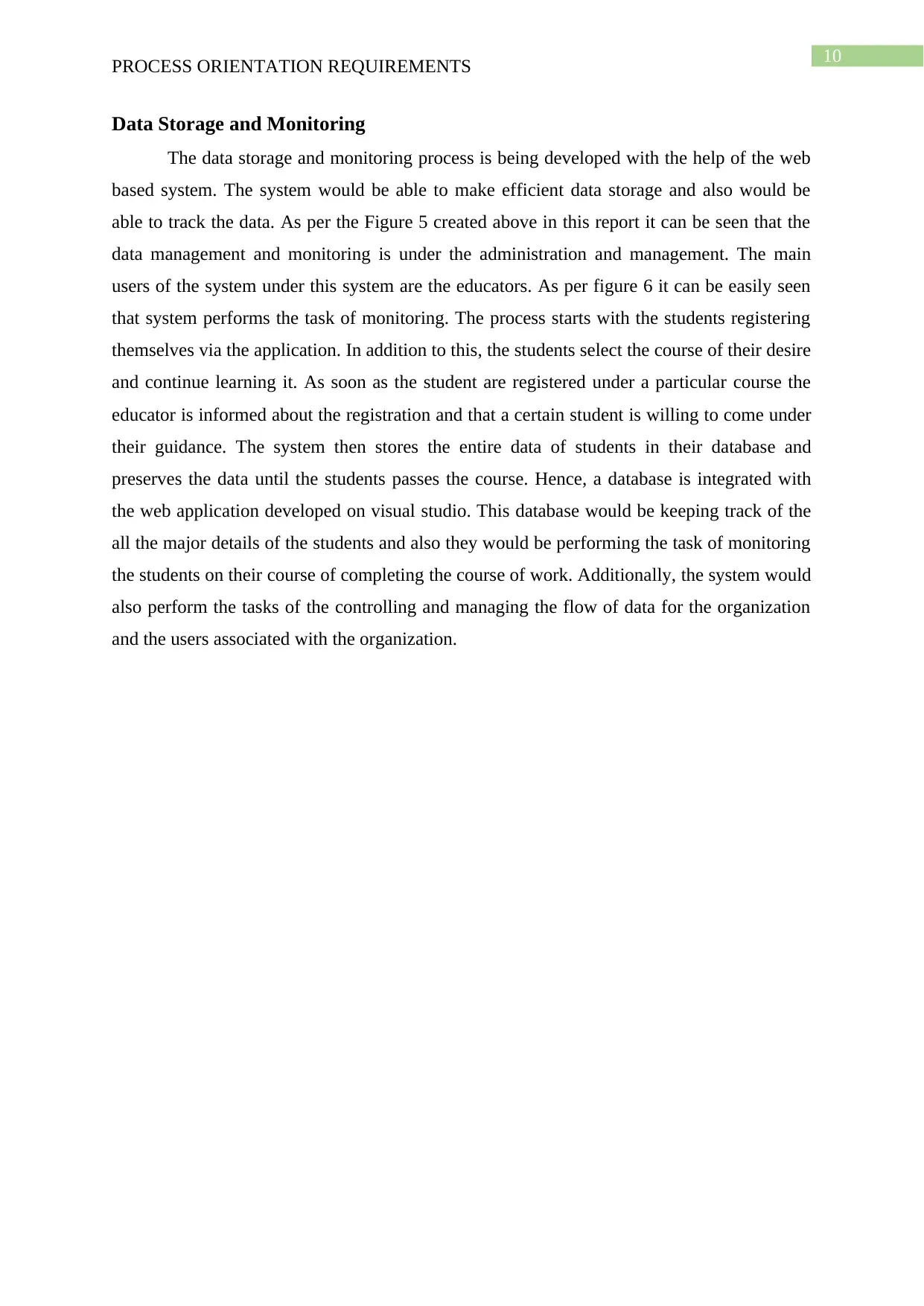
10
PROCESS ORIENTATION REQUIREMENTS
Data Storage and Monitoring
The data storage and monitoring process is being developed with the help of the web
based system. The system would be able to make efficient data storage and also would be
able to track the data. As per the Figure 5 created above in this report it can be seen that the
data management and monitoring is under the administration and management. The main
users of the system under this system are the educators. As per figure 6 it can be easily seen
that system performs the task of monitoring. The process starts with the students registering
themselves via the application. In addition to this, the students select the course of their desire
and continue learning it. As soon as the student are registered under a particular course the
educator is informed about the registration and that a certain student is willing to come under
their guidance. The system then stores the entire data of students in their database and
preserves the data until the students passes the course. Hence, a database is integrated with
the web application developed on visual studio. This database would be keeping track of the
all the major details of the students and also they would be performing the task of monitoring
the students on their course of completing the course of work. Additionally, the system would
also perform the tasks of the controlling and managing the flow of data for the organization
and the users associated with the organization.
PROCESS ORIENTATION REQUIREMENTS
Data Storage and Monitoring
The data storage and monitoring process is being developed with the help of the web
based system. The system would be able to make efficient data storage and also would be
able to track the data. As per the Figure 5 created above in this report it can be seen that the
data management and monitoring is under the administration and management. The main
users of the system under this system are the educators. As per figure 6 it can be easily seen
that system performs the task of monitoring. The process starts with the students registering
themselves via the application. In addition to this, the students select the course of their desire
and continue learning it. As soon as the student are registered under a particular course the
educator is informed about the registration and that a certain student is willing to come under
their guidance. The system then stores the entire data of students in their database and
preserves the data until the students passes the course. Hence, a database is integrated with
the web application developed on visual studio. This database would be keeping track of the
all the major details of the students and also they would be performing the task of monitoring
the students on their course of completing the course of work. Additionally, the system would
also perform the tasks of the controlling and managing the flow of data for the organization
and the users associated with the organization.
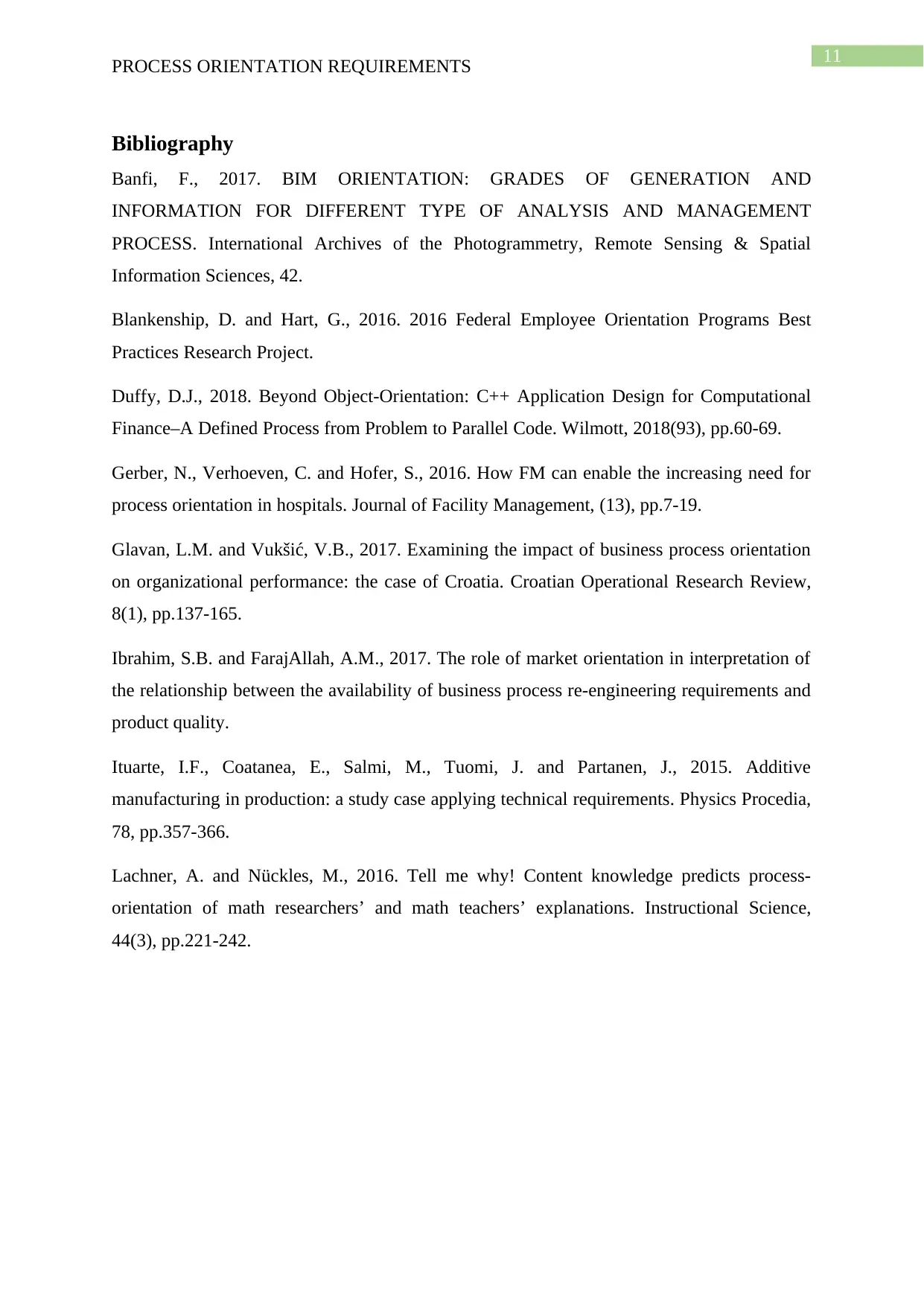
11
PROCESS ORIENTATION REQUIREMENTS
Bibliography
Banfi, F., 2017. BIM ORIENTATION: GRADES OF GENERATION AND
INFORMATION FOR DIFFERENT TYPE OF ANALYSIS AND MANAGEMENT
PROCESS. International Archives of the Photogrammetry, Remote Sensing & Spatial
Information Sciences, 42.
Blankenship, D. and Hart, G., 2016. 2016 Federal Employee Orientation Programs Best
Practices Research Project.
Duffy, D.J., 2018. Beyond Object‐Orientation: C++ Application Design for Computational
Finance–A Defined Process from Problem to Parallel Code. Wilmott, 2018(93), pp.60-69.
Gerber, N., Verhoeven, C. and Hofer, S., 2016. How FM can enable the increasing need for
process orientation in hospitals. Journal of Facility Management, (13), pp.7-19.
Glavan, L.M. and Vukšić, V.B., 2017. Examining the impact of business process orientation
on organizational performance: the case of Croatia. Croatian Operational Research Review,
8(1), pp.137-165.
Ibrahim, S.B. and FarajAllah, A.M., 2017. The role of market orientation in interpretation of
the relationship between the availability of business process re-engineering requirements and
product quality.
Ituarte, I.F., Coatanea, E., Salmi, M., Tuomi, J. and Partanen, J., 2015. Additive
manufacturing in production: a study case applying technical requirements. Physics Procedia,
78, pp.357-366.
Lachner, A. and Nückles, M., 2016. Tell me why! Content knowledge predicts process-
orientation of math researchers’ and math teachers’ explanations. Instructional Science,
44(3), pp.221-242.
PROCESS ORIENTATION REQUIREMENTS
Bibliography
Banfi, F., 2017. BIM ORIENTATION: GRADES OF GENERATION AND
INFORMATION FOR DIFFERENT TYPE OF ANALYSIS AND MANAGEMENT
PROCESS. International Archives of the Photogrammetry, Remote Sensing & Spatial
Information Sciences, 42.
Blankenship, D. and Hart, G., 2016. 2016 Federal Employee Orientation Programs Best
Practices Research Project.
Duffy, D.J., 2018. Beyond Object‐Orientation: C++ Application Design for Computational
Finance–A Defined Process from Problem to Parallel Code. Wilmott, 2018(93), pp.60-69.
Gerber, N., Verhoeven, C. and Hofer, S., 2016. How FM can enable the increasing need for
process orientation in hospitals. Journal of Facility Management, (13), pp.7-19.
Glavan, L.M. and Vukšić, V.B., 2017. Examining the impact of business process orientation
on organizational performance: the case of Croatia. Croatian Operational Research Review,
8(1), pp.137-165.
Ibrahim, S.B. and FarajAllah, A.M., 2017. The role of market orientation in interpretation of
the relationship between the availability of business process re-engineering requirements and
product quality.
Ituarte, I.F., Coatanea, E., Salmi, M., Tuomi, J. and Partanen, J., 2015. Additive
manufacturing in production: a study case applying technical requirements. Physics Procedia,
78, pp.357-366.
Lachner, A. and Nückles, M., 2016. Tell me why! Content knowledge predicts process-
orientation of math researchers’ and math teachers’ explanations. Instructional Science,
44(3), pp.221-242.
You're viewing a preview
Unlock full access by subscribing today!
1 out of 12
Related Documents
Your All-in-One AI-Powered Toolkit for Academic Success.
+13062052269
info@desklib.com
Available 24*7 on WhatsApp / Email
![[object Object]](/_next/static/media/star-bottom.7253800d.svg)
Unlock your academic potential
© 2024 | Zucol Services PVT LTD | All rights reserved.





